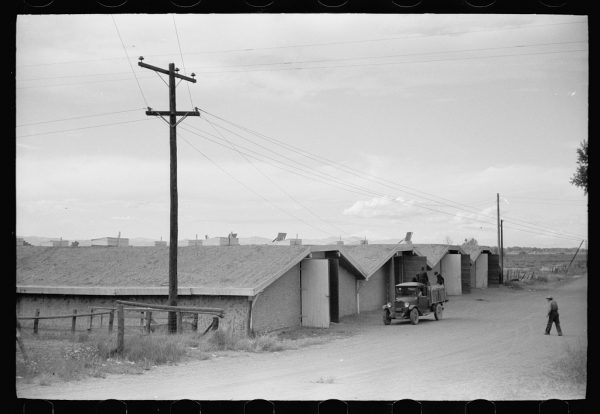Every February, Colorado Preservation Inc. (CPI) releases their annual list of Colorado’s Most Endangered Places. The program brings awareness to historic buildings, landscapes, or archaeological sites around Colorado that are in danger of demolition, neglect, modification, or development. This year’s endangered places, highlighting the history of southern Colorado, are:
- Adobe Potato Cellars of the San Luis Valley (Alamosa, Conejos, Costilla, Rio Grande, and Saguache Counties)
- Hose Company No. 3 Fire Museum (Pueblo County)
- Iglesia De San Antonio-Tiffany Catholic Church (La Plata County)
- McIntire Ranch and Mansion (Conejos County)
- R&R Market (Costilla County)
The Culebra River Villages of Costilla County, Colorado, a Colorado Historical Society publication available from our library, mentions the history of the adobe potato cellars:
An important consideration involved storage. When Anglo growers first marketed potatoes they stored surpluses above ground in circular wire-frames encased with hay or in straw-covered trenches. However, the Rio Culebra farmers preferred to store potatoes in a large, underground cellars, or soterranos. Because Hispano[s] used earth, not sod, for walls, their structures maintain an even temperature that kept potatoes from freezing. Hispano subterranean structures were so efficient and cheap to fabricate that Anglo farmers throughout the San Luis Valley adopted double-wall adobe construction for their above-ground storage facilities.

A second Historical Society publication offers information about Conejos County’s McIntire Ranch. An Archaeological Inventory in the Pike’s Stockade Area, Conejos County, Colorado discusses the ranch site‘s historical and archaeological resources, including what remains of the large adobe ranch house. The ranch belonged to Albert McIntire, governor of Colorado from 1895 to 1897. You can read about adobe construction in Adobe as a Building Material for the Plains and Adobe Brick for Farm Buildings, two early-twentieth-century publications from the Colorado Agricultural Experiment Station.
To learn more about historic preservation and its impact on Colorado communities, see Preservation for a Changing Colorado, a 2017 publication of CPI and History Colorado. Search our library’s online catalog for more Colorado history resources.
- How to Spot the Differences Between Eagles and Hawks - August 16, 2021
- How Transportation Projects Help Tell the Story of Colorado’s Past - August 9, 2021
- Time Machine Tuesday: The Night the Castlewood Canyon Dam Gave Way - August 3, 2021